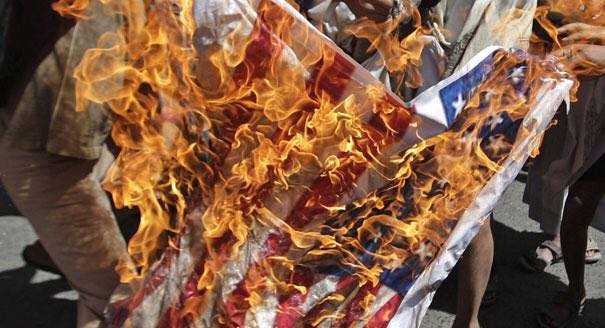
31 Oct IF THE FLAG STANDS FOR ANYTHING…
IF THE FLAG STANDS FOR ANYTHING…
The Story of Texas v. Johnson, and why Colin Kaepernick is doing something “American”
On August 22, 1984, people gathered in downtown Dallas, Texas. Many were there to pledge their support and witness President Ronald Reagan accept the Republican nomination. Others were gathering to make a different statement, and to protest. One of these protestors was a man by the name of Gregory Johnson.
Johnson was there to participate in a political demonstration called the “Republican War Chest Tour”. The aim of the demonstration was to protest the policies of several Dallas-area businesses and the Reagan administration. The demonstration was pretty typical. About 100 persons participated, they marched, chanted, staged “die-ins” vandalized some businesses with spray paint, and generally made a nuisance of themselves. Other than being an annoyance, they garnered little attention, that was until someone brought Johnson a flag.
When the band of merry marauders came to stop outside of the Dallas City Hall, one of the group brought Johnson a flag that had been stolen from a business nearby. Johnson took out some kerosene, doused the flag, and set it ablaze. As the flag burned, Johnson led the group chanting, “Reagan, Mondale which will it be? Either one means World War III;” “Ronald Reagan, killer of the hour, Perfect example of U.S. power;” and “red, white and blue, we spit on you, you stand for plunder, you will go under.”
Johnson was arrested, charged and convicted for desecration of a venerated object in violation of Texas Penal Code. He was sentenced to one year in jail and fined $2,000.00.
Johnson did appeal to the Fifth Court of Appeals in Texas, but lost. He then appealed to the highest appellate court in Texas, the Texas Court of Criminal Appeals. This court overturned Johnson’s conviction on the principle that Johnson’s actions were protected by the First Amendment of the United States Constitution as protected speech. The state of Texas asked the United States Supreme Court to review, and Texas v. Johnson was scheduled for argument.
ENTER THE RADICAL LAWYER
Burning the flag of the United States of America is a radical act. Well, if you are going to defend a radical act, then you need a radical lawyer. Up to this point Johnson’s case had been handled by attorneys at the ACLU. When the case was slated for argument the ACLU reached out to William Kunstler to present their argument to the Court.
I have written about Kunstler before. Bill lived his life as a radical. Wherever you found government exercising power over the individual, Kunstler was there, usually raising his fist in protest, shouting at the top of his booming voice, and being arrested in solidarity with his clients. His career began as a civil rights lawyer in the south, facing off with hard line southern racists hell bent on preserving Jim Crow. Then he moved on to defending protestors of the Vietnam war, most famously defending the Chicago Seven. When the trial of the Chicago Seven concluded, Kunstler had racked up over four years of contempt time from the judge that presided over the case (an appellate court would later set aside those contempt charges). Some of you may recall the story I wrote about Wounded Knee, William Kunstler was there.
Gregory Johnson was hated by most Americans. Few people like a punk who travels around the country as a professional protestor, and then you add the fact that he lights up a symbol of national pride, well you have a great recipe for someone most people are not going to like very well. As much as the public might have hated Gregory Johnson, William Kunstler was once described by the New York Times as the most hated man in America. Surely, this isn’t gonna be close, right?
TEXAS v. JOHNSON
On March 29, 1989, Chief Justice William Renquist called the case for argument.
In the book, “My Life As A Radical Lawyer”, William Kunstler wrote:
“I made my point, that the person who burned the flag did not intend to do anything other than exercise his right to free speech.
In response to a question from Chief Justice Rehnquist, I argued:
To me, this was one of my most important cases because it went to the heart of the First Amendment. I told the court:
To hear things or to see things that we hate tests the First Amendment more than seeing or hearing things that we like. It wasn’t designed for things we like. They never needed a First Amendment for that. This amendment was designed so that the things we hate can have a place in the marketplace of ideas and can have an area where protest can find itself.” (My Life As A Radical Lawyer, William M. Kunstler p368-369)
The Court decided in favor of Johnson in a close 5-4 decision. Justice William J. Brennan would deliver the court and be joined in the majority by Justices Scalia, Marshall, Blackmun, and Kennedy. Kennedy wrote a concurring opinion and summed up the spirit of the majority’s decision:
“For we are presented with a clear and simple statute to be judged against a pure command of the Constitution. The outcome can be laid at no door but ours. The hard fact is that sometimes we must make decisions we do not like. We make them because they are right, right in the sense that the law and the Constitution, as we see them, compel the result. And so great is our commitment to the process that, except in the rare case, we do not pause to express distaste for the result, perhaps for fear of undermining a valued principle that dictates the decision. This is one of those rare cases.”
“Though symbols often are what we ourselves make of them, the flag is constant in expressing beliefs Americans share, beliefs in law and peace and that freedom which sustains the human spirit. The case here today forces recognition of the costs to which those beliefs commit us. It is poignant but fundamental that the flag protects those who hold it in contempt.”
The Court’s decision was wide and sweeping, it invalidated similar laws in 48 of the 50 states. Congress reacted by passing the 1989 Flag Protection Act, which made it a federal crime to desecrate the flag. In the case U.S. v. Eichman, the same five person majority struck down the federal statute. Since then Congress has considered a Constitutional Amendment to ban desecrating the flag on several occasions, but the attempt has continuously failed in the U.S. Senate, most recently in 2006. Still today polls show that a majority of Americans support a ban on flag burning.
Recently, San Francisco Quarterback Colin Kaepernick has caught the attention of many in his conscience refusal to stand during the playing of the National Anthem. He has made it clear that his decision to do so is in fact a protest. The anthem much like the flag is a symbol and to intentionally show disrespect will naturally draw out emotion. I can state for me personally, that it makes me cringe. However, I also recognize that much like burning the flag, I can think of few things that illustrate more what it really means to be an “American”.
The United States Constitution is the bedrock of our democracy, and the Amendments are the shield that protects the individual against the weight and power of masses and the government. The very first of those amendments protects one’s ability to criticize, insult and scorn the very thing that we all share. We created a government that put dissent as number one on the list; to be the very foundation of ultimately what brings us together. As strange as that statement sounds it is what unites Americans above all else, and make us the land of the free.
I have have no problem living in a country in which we don’t like it when people like Gregory Johnson and Colin Kaepernick do the things they do, and they are socially vilified. However, I fear nothing more than the prospect of living in a country where it is acceptable to throw someone in prison because the majority doesn’t like what they have to say.



No Comments